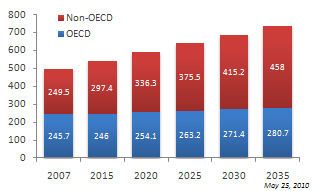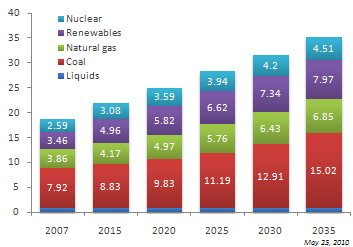|
Residential and commercial buildings
- The buildings sector-comprising residential and commercial consumers-accounts for about one-fifth of the world's total delivered energy consumption
- In the residential sector, energy use is defined as the energy consumed by households, excluding transportation uses
- The type and amount of energy used by households vary from country to country, depending on income levels, natural resources, climate, and available energy infrastructure
- Typical households in OECD nations use more energy than those in non-OECD nations, in part because higher income levels in OECD nations support purchases of larger homes and more energy-using equipment.
- In the IEO2010 Reference case, world residential energy use increases by 1.1 percent per year over the projection period, from 50 quadrillion Btu in 2007 to 69 quadrillion Btu in 2035
- Much of the growth in residential energy consumption occurs in non-OECD nations, where robust economic growth improves standards of living and fuels demand for residential energy
- Non-OECD residential energy consumption rises by 1.9 percent per year, compared with the much slower rate of 0.4 percent per year for OECD countries, where patterns of residential energy use already are well established, and slower population growth and aging populations translate to smaller increases in energy demand
Back to Top
|




 ABOUT US
ABOUT US










